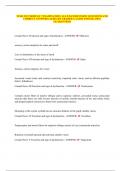NURS 5315 MODULE 7 EXAMINATION. ALL EXAM REVISION QUESTIONS AND
CORRECT ANSWERS (ALREADY GRADED A+) (2024 UPDATE) 100%
GUARANTEED
Cranial Nerve I Function and sign of dysfunction - ANSWER- Olfactory
sensory, carries impulses for sense and smell
Loss or disturbance in the sense of smell
Cranial Nerve II Function and sign of dysfunction - ANSWER- Optic
Sensory, carries impulses for vision
decreased visual acuity and contrast sensitivity, impaired color vision, and an afferent pupillary
defect. (blindness)
Cranial Nerve III Function and sign of dysfunction - ANSWER- Oculomotor
Contains motor fibers to interior oblique and to superior, inferior, ad medial rectus extraocular
muscles that direct eye ball; levator muscles of eyelid; smooth muscles of iris and ciliary body;
and proprioception (sensory) to brain from extraocular muscles
Drooping of the eyelid, eyeball moves outward, dilation of the pupil, double vision.
Cranial Nerve IV Function and sign of dysfunction - ANSWER- Trochlear
Propioceptor and motor fibers for superior oblique muscle of eye (extraocular muscles)
Rotation of eyeball upward and outward, double vision
Cranial Nerve V Function and sign of dysfunction - ANSWER- Trigenimal
,(facial muscles including chewing, facial sensation) This is the largest cranial nerve Both motor
and sensory for face; conducts sensory impulses from mouth, nose, surface of eye, and dura mater;
also contains motor fibers that stimulate chewing muscles
Sensory root - Pain or loss of sensation in the face, forehead, temple and eyes.
Motor root - affecting the jaw, trouble chewing
Cranial Nerve VI Function and sign of dysfunction - ANSWER- Abducems
Moves the eyeballs outwards by sending nerve impulses to the lateral rectus muscles
Deviation of the eyes outward; double vision
Cranial Nerve VII Function and sign of dysfunction - ANSWER- Facial
(taste, tears, saliva and facial expressions);
Mixed: 1. Supplies motor fibers to muscles of facial expression and to the lacrimal and salivary
glands.
2. Carries sensory fibers from taste buds of anterior part of tongue
Paralysis of all the muscles in one side of the face, inability to wrinkle the forehead, close the eye,
whistle, deviation of the mouth. Bell's Palsy
Cranial Nerve VIII Function and sign of dysfunction - ANSWER- Vestibulocochlear
(acoustic) auditory: Purely sensory; vestibular branch transmits impulses for sense of equilibrium,
cochlear branch transmits impulses for sense of hearing
Deafness or ringing in the ears, dizziness, nausea and vomiting
Cranial Nerve IX Function and sign of dysfunction - ANSWER- Glossopharyngeal
(swallowing, saliva, taste)
, Mixed: 1. Motor fibers serve pharynx and salivary glands. 2. Sensory fibers carry impulses from,
pharynx, posterior tongue, and pressure receptor of carotid artery (blood pressure)
Disturbance of taste; Difficulty in swallowing
Cranial Nerve X Function and sign of dysfunction - ANSWER- Vagus
(control of PNS: smooth muscles of GI tract); Sensory and motor impulses for pharynx; a large
part of this nerve is parasympathetic motor fibers, which supply smooth muscles of abdominal
organs
Hoarseness and difficulty swallowing and talking.
This nerve also regulates the heart, blood vessels and digestion resulting in irregular heartbeat and
lowered blood pressure. It regulates the stomach telling it to move food through the digestive
system, thus damage can result in decreased digestion and thus nausea, bloating and vomiting.
Cranial Nerve XI Function and sign of dysfunction - ANSWER- Spinal Accessory
(Moving head & shoulders, swallowing); provides sensory and motor fibers for
sternocleidomastoid and trapezius muscles (movement of head and shoulders) and muscles of soft
palate, pharynx, and larynx (swallowing)
Dropping of the shoulder; inability to rotate the head away from affected area.
Cranial Nerve XII Function and sign of dysfunction - ANSWER- Hypoglossal
(tounge muscles, speech, swallowing);Carries motor fibers to muscles of tongue and sensory
impulses from tongue to brain.
Paralysis of one side of the tongue; deviation of tongue toward paralyzed side; thick speech.
Cerebrum Location, Function, Signs of injury/lesion/disorder - ANSWER- Largest, most upper
portion of the brain. Divided into left and right hemispheres.




